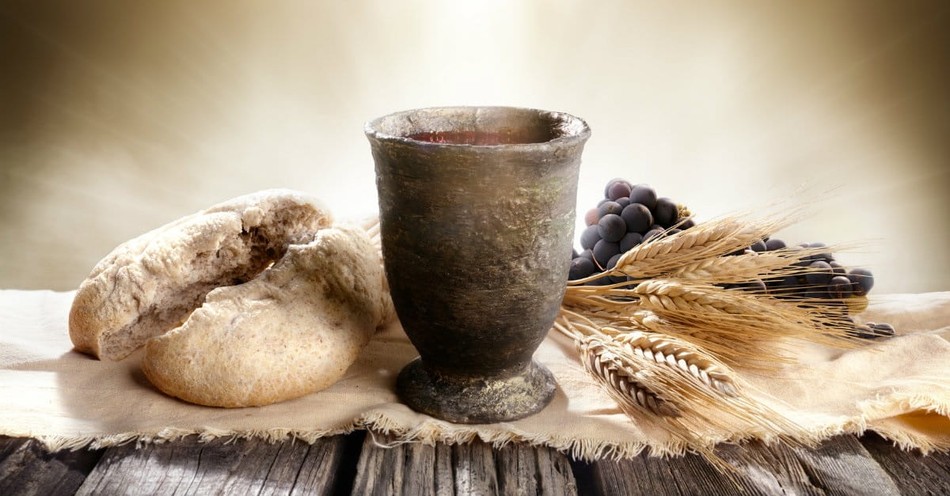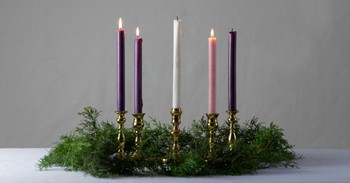In a Christianity.com interview with Matthew Smith, “How Can We Determine What Kind of Music is Best for Worship?” Smith makes a case for “lyrics that display Jesus.” A hymn or worship song should be beautiful and holy, he says. These qualities allow a listener or singer to “step into the story.”
The following communion hymns do just that. Whatever their style or culture, they serve as vehicles for worship. Each of these communion songs draws a communicant’s spirit closer to God, refreshing praise for His Son Jesus’ sacrifice. These hymns are particularly appropriate for the Easter season, but can be used year-round.
What Happened at the First Communion?
The synoptic gospels of Matthew, Mark, and Luke record Jesus instituting communion at the Last Supper. As Luke tells it:
“And he took bread, gave thanks and broke it, and gave it to them, saying, ‘This is my body given for you; do this in remembrance of me.’ In the same way, after the supper he took the cup, saying, ‘This cup is the new covenant in my blood, which is poured out for you.’” (Luke 22:19-20).
Later, when Jesus breaks bread with the disciples after his death, they recognize that the visiting stranger is Jesus (Luke 24:30-31). We meet Jesus in communion.
First Corinthians 11:26 says, “For whenever you eat this bread and drink this cup, you proclaim the Lord’s death until he comes.” Jesus’ life, death, and resurrection changed Christian history. We continue to celebrate the Christian life in communion services in our time. Music enhances the service as celebrants file up to the church’s front to be served the bread and wine, or pass trays down their pews to receive the gifts of communion.
Here are some hymns traditionally used in Christian communion services.
What Are Three Traditional Communion Hymns?
These hymns have been helping churches think about what the bread and the wine symbolize for generations.
1. 'Nothing but the Blood of Jesus'
This hymn, written by the Reverend Robert Lowry in 1876, is cited as the fifth most popular Baptist hymn. The first publication of “Nothing but the Blood of Jesus” included as its subtitle a quotation from Hebrews 9:22: “Without the shedding of blood there is no remission of sin.” This biblical truth is paraphrased in the lyric, “Naught of good that I have done/ nothing but the blood of Jesus.” In this image, Jesus’ blood, shed in His sacrifice on the cross, cleanses us from sin. We are no longer separated from God.
This is made clear in these lyrics:
What can wash away my sin?
Nothing but the blood of Jesus.
What can make me whole again?
Nothing but the blood of Jesus.
There have been many great performances of this hymn over the years. For example, Vince Gill and Amy Grant performed “Nothing But The Blood” at the 34th Annual Dove Awards, which recognizes Christian and gospel music.
2. 'Are You Washed in the Blood'
Another traditional communion song, “Are You Washed in the Blood?” was written by E.A. Hoffman, a prolific hymnist. Hoffman wrote over 2,000 gospel songs (including “Leaning on the Everlasting Arms”). Originally published in 1878, “Are You Washed in the Blood?” is still a popular Christian hymn—it appears in over 400 hymnals. The song invites the listener or singer to accept Jesus’ sacrifice for our sins and join His family of believers.
Have you been to Jesus for the cleansing power?
Are you washed in the blood of the Lamb?
Are you fully trusting in His grace this hour?
Are you washed in the blood of the Lamb?
Scripture describes Jesus’ blood washing away our sins in 1 John 1:7: “But if we walk in the light, as he is in the light, we have fellowship with one another, and the blood of Jesus his Son cleanses us from all sin.” God’s grace purifies us.
The song has been performed by solo artists (like Alan Jackson on his 2008 album Precious Memories) and by groups, like this performance by the Statler Brothers:
3. 'Let Us Break Bread Together'
The original version of “Let Us Break Bread Together” was sung by people living on South Carolina’s coast, an area today known as the Gullah Geechee Cultural Heritage Corridor. Gullah Geechee (sometimes just Gullah or just Geechee) refers to a distinct African-American culture in that area (part of South Carolina’s Lowcountry).
Like many African-American traditional songs, it’s unclear who wrote “Let Us Break Bread Together,” assuming there’s a single songwriter. It likely developed over time, possibly several generations.
The music and lyrics were first published in The Journal of American Folklore in 1925. The Journal included spirituals, African-American folk tales, and proverbs, all collected by students at the Penn School on Saint Helena Island, South Carolina.
Here are the lyrics of the third stanza of “Let Us Break Bread Together” in the Gullah dialect:
We will eat bread tuhgedduh on dat day,
We will eat bread tuhgedduh on dat day,
En I’ll fall upon mah knees
En face duh risin’ sun,
Oh, Lawd, hab mussy on me.
In the years of slavery, singing this song sent a message through the enslaved Gullah people’s community. The song expressed an intention to escape bondage. Singing songs with covert messages was one of the Underground Railroad’s strategies.
The hymn is still commonly sung in holy communion services, reminding us of our spiritual food and drink symbolized through the bread and wine.
Classically-trained opera singer Jessye Norman gives a beautiful rendition of “Let Us Break Bread Together On Our Knees” from her 2012 album Amazing Grace.
What Are Four Modern Communion Hymns?
These hymns are newer but no less inspiring.
1. 'I am the Bread of Life'
In the 1960s and 1970s, Christian artists revived worship music. “I Am the Bread of Life,” composed by Sr. Suzanne Toolan in 1966, is based on Jesus’ message to His disciples, recorded in John 6:35: “I am the bread of life. Whoever comes to me will never go hungry, and whoever believes in me will never be thirsty.” The frequently baffled disciples may have understood this message of Christ; they may have grasped the food imagery—how basic it is to life.
In this recording, the musicians and choir of St. Francis de Sales Church in Ajaz, Ontario, sing “I Am The Bread of Life” in a slow, traditional style. Notice the painting of the Last Supper at the beginning of the video.
2. 'I Am the Resurrection and the Life'
The title of this song is taken from words Jesus spoke to Martha when He visited her and her sister Mary’s home and raised their brother Lazarus from the dead. In John 11:25-26, “Jesus said to her, ‘I am the resurrection and the life. The one who believes in me will live, even though they die; and whoever lives by believing in me will never die.’”
Ray Repp, a social activist, and Roman Catholic seminary student, wrote the song “I Am the Resurrection and the Life,” based on the scripture found in John 11. His own company, Otter Creek Music, published the song in 1967. It was routinely sung at Vietnam soldiers’ funerals and Bible camps from the 1970s to the 1990s. You can find “I Am the Resurrection and the Life” in Glory and Praise, a once-popular collection of hymns for young people and those young at heart.
Here is Ray Repp’s recording of “I Am the Resurrection and the Life” from a 1966 folk mass.
3. 'One Bread, One Body'
Jesuit Father John Foley originally composed “One Bread, One Body” in 1978, and it has become a classic song of faith and thanksgiving. The song is a beautiful reminder of Jesus’ great sacrifice for us and emphasizes the message of 1 Corinthians 10:17: “Because there is one loaf, we, who are many, are one body, for we all share the one loaf.” This song reminds us of our unity as Christians and people of faith. It is a message desperately needed today.
This beautiful rendition of “One Bread, One Body” features a woman soloist and piano accompaniment at St. Francis de Sales Church in Ajaz, Ontario. Paintings of Jesus preaching to crowds illustrate the video.
4. 'Taste and See'
“Taste and See” was written in 1983 by James E. Moore, Jr. (1951-2022), a seminary professor of music and music director in Europe. The song puts Psalm 34 to music. It is sung worldwide and is particularly appropriate for communion services.
Traditional or modern, as the hymns accompany communion services, they can raise worship to a higher level. We commune through music as we receive the gifts of bread and wine, representing Christ’s body and blood, sacrificed to restore and build our relationship with God.
Further Reading:
4 Christian Poems to Inspire Believers
Who Wrote the Song 'Be Still for the Presence of the Lord'?
Who Wrote "Lion and the Lamb" and What Does It Mean?
What Can We Learn from the Hymn 'He Lives'?
Photo Credit: Getty Images/RomoloTavani




.jpg)
.jpg)